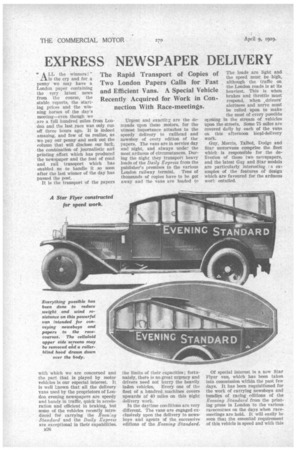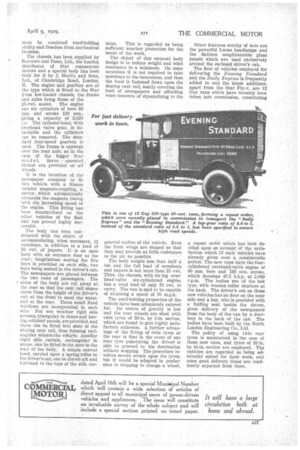EXPRESS NEWSPAPER DELIVERY
Page 52

Page 53

If you've noticed an error in this article please click here to report it so we can fix it.
4., A LL the winners!
is Ills the cry and for a penny we may have a London paper containing the very latest news from the course, the stable reports, the starting prices and the winning horses of the day's meeting—even though we .
are a full hundred miles from London anti the last .race was only run off three hours ago. It is indeed amazing, and few of us realize, as we pay our penny and seek out the column that will disclose our luck, the combination of journalistic and printing effort which has produced the newspaper and the feat of road and rail transport which has enabled us to handle it so soon after the last winner of tile day has passed the post ..
It is the transport of the papers
with which we are concerned and the part that is played by motor vehicles is our especial interest. It is well known that all the delivery vans used by the proprietors of London evening newspapers are speedy anti handy in traffic, quick in acceleration and efficient in braking, but some of the vehicles recently introduced for carrying the Even-:ng Standard and the Daily Express are exceptional in their capabilities.
B26
Urgent and exactirg are the demands upon these motors, for the utmost importance attaches to the speedy delivery to railhead and newsboy of every edition of the papers. The vans are in service day and night, and always under the most arduous of circumstances. During the night they transport heavy loads of the Daily Express from the publisher's premises to the various London railway termini. Tens of thousands of copies have to be got away and the vans are loaded to the limits of their capacities; fortunately, there is no great urgency and drivers need not hurry the heavily laden vehicles. Every one of the fleet of a hundred machines covers upwards of 40 miles on this night delivery work.
In the daytime conditions are very different The vans are engaged exclusively upon the delivery to newsboys and agents of the successive editions of the Evening Standard.
The loads are light and the speed must be high, although the traffic on the London roads is at its heaviest. This is when brakes and throttle must respond, when ,drivers' alertness and nerve must be relied upon to make the most of every possible opening in the stream of vehicles upon the streets, Some 75 miles are covered daily by each of the vans on this afternoon local-delivery work.
Guy, Morris, Talbot, Dodge and Star motorvans comprise the fleet which is responsible for the deliveries of these two newspapers, and the latest Guy and Star models are particularly interesting rs examples of the features of design which are favoured for the arduous work entailed.
Of special interest is a new Star Flyer van, which has been taken into commission within the past few days. It has been requisitioned for the work of carrying newsboys and bundles of racing editions of the Evening Standard from the printing press in London to the various racecourses on the days when racemeetings are held. It will easily be seen that the essential requirement of this vehicle is speed and with this
must be combined road-holding ability and freedom from mechanical troubles.
The chassis has been supplied hy Burrows and Dunn, Ltd., the London distributor of Star commercial motors and a special body has been built for it by J. Harlin and Sons, Ltd.' of Cambridge Road, London, E. The engine and gearbox are of the type which IS fitted to the Star 2-ton low-loader chassis, the -frame and axles being those of the 25-cwt. model. The engine has six cylinders of bore 80 mm. and stroke 120 mm., giving a capacity of 3,620 c.c. The cylinder-head, with overhead valve gear, is• detachable and the cylinders can be removed. The standard four-speed gearbox is used. The frame is upswept over the rear axle, as in the case of the bigger Star model. Servo operated brakes are provided onall wheels.
It is the intention of the newspaper company to fit this vehicle with a Simms vernier magneto-coupling, a device which automatically advances the magneto timing with the increAing speed of the engine. This fitting has been standardized on the other vehicles of the fleet and has proved highly successful.
The body has been constructed with the object of accommodating, when necessary, 12 newsboys, in addition to a load of ,10 cwt. of .Dapeks. It is an open body with an entrance door at the rear; longitudinal seating for five boys is,provided on each side,, two boys being seated in the driver's cab. The newspapers are placed between the two rows of passengers. The sides of the body are cut away at the rear so that the cant rail slopes down from the height of the driver's cab at the frOnt to meet the waistrail at the rear. Three small fixed windows are incorporated in each side. For, wet weather rigid side screens, triangular in shape and having celluloid panels, areprovidecl, and these can be fitted into slots in the sloping cant rail, thus forming rectangular sidestothe vehicle. Anotlier rigid side curtain, rectangular in shape, can be fitted to the door in the rear of the body. A simple canvas hood, carried upon a spring roller in the driver's cab, can be drawn aft and buttoned to the tops of the sid'e cur For
talus. This is regarded as being sufficient weather protection for the needs of the work, The object of this unusual body design is to reduce weight and wind resistance to a minimum. On some occasions it is not required to take newsboys to the racecourse, and then the hood is fastened down upon the sloping cant rail, neatly covering the load of newspapers and affording some measure of streamlining to the general outline of the vehicle. Even the front wings are shaped 'so that they may provide as little resistance to the air as possible.
The body weighs less than half a ton and the full load of newsboys and papers is not more than 25 cwt. Thus, the chassis, with its big overhead-valve six-cylindered engine, has a total load of only 35 cwt. to carry. The van is said to he capable of attaining a speed of 70 m.p.h.
The road-holding properties of the vehicle have been adequately catered for. Its centre of gravity is low and the rear wheels are shod with twin tyres of 33-in. by 5-in. section, which are found to give highly satisfactory adhesion. A further advantage of the fitting of twin tyres at the rear is that in the event of one rear tyre puncturing the drivel,. is able to proceed to his destination without stopping. The procedure involves severe strain upon the tyres, but it would be adopted in preference to stopping to change a wheel.
Other features worthy of note are the powerful Lucas headlamps and the Safetex unsplinterable glass panels which are used exclusively around the enclosed driver's cab.
The fleet of vehicles employed for delivering the _Evening Standard and the Daily Express is frequently added to and the latest additions, apart from the Star Flycr, are 12 Guy vans which have recently been taken into commission, constituting
a repeat order which has been decided upon on account of the satisfaction which 13 such vehicles have already given over a considerable period. The new vans have the fourcylindered overhea.d-valve engine of 90 mm. bore and 130 nun.stroke, which develops 47,5 b.h.p. at 2,000 r.p.m. The bodies are of the box type, with wooden roller shutters at the back. The driver's cab on these new vehicles has no door on the near side and a boy, who is provided with a folding seat beaide the driver, gives delivery of the newspapers from the body of the van by a doorWay in the back of the cab. The bodies have been built by the North London Engineering Co., Ltd. The policy of using twin rear tyres is maintained in the case of these new vans, and tyres of 32-in. by 4i-in. section are employed. The vehicles are regarded as being admirably' suited for their work, and some good, delivery -times are confidently expected from them.




















































































































